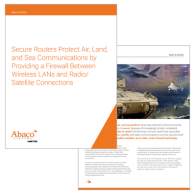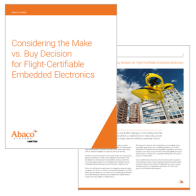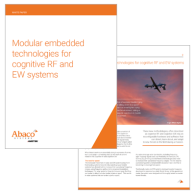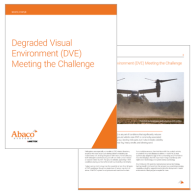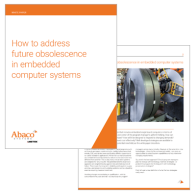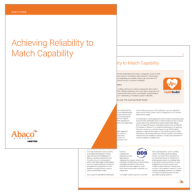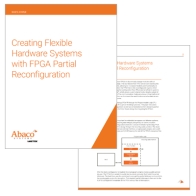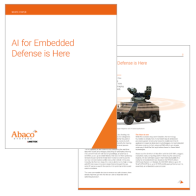Share
Share
Share
Share
Share
Share
Share
Search
White Papers
| Title: | Release Date | Description |
|---|---|---|
| Metadata Handling in Rugged Embedded Video Compression Systems | August 2015 | Video data handling in rugged embedded compu ng environments has an immensely varied range of applica ons and requirements. Developing products that enable the e ec ve handling of not just video, but also corresponding audio and metadata, is a signi cant challenge. |
| GStreamer Optimized Multimedia Processing for Audio and Video | October 2015 | GStreamer is a platform-independent (Microsoft® Windows®, Linux®, Android™, OS X®, BSD, OpenSolaris) multimedia framework for constructing modular processing pipelines using an extensible plug-in architecture. Applications range from simple Ogg Vorbis playback and audio/video streaming to complex audio (mixing), video (non-linear editing) processing, metadata, subtitles and much more. Today, GStreamer is used in many open source applications including Totem, Rhythmbox and Songbird as well as being heavily utilized by the GNOME desktop environment under Linux. |
| Anti-Tamper Technology: Safeguarding Today’s COTS Platforms | January 2016 | Secure embedded computer and communications systems are critical for mission success in today’s environment of escalating cyber threats. Data integrity must be protected as it is processed, stored, and transmitted. The strategic risk management of these systems is known as Information Assurance (IA), which entails a combination of physical, technical, and administrative controls. At the core of an assured system is an authentic, trusted foundation based on Anti-Tamper (AT) safeguards using layered security features at the hardware, firmware, and software level. Abaco Systems is responding to the need for assured systems by incorporating product features that enable anti-tamper safeguards. This paper focuses on the use of COTS anti-tamper frameworks to support secure platforms and provide information assurance. |
| Selecting a Bus Analyzer 101 | March 2016 | As Avionics buses on military and commercial aircraft become more varied and complex, a bus analyzer has become an important tool for use during integration, validation, deployment, and maintenance of avionics systems. Today's aircraft may contain MIL-STD-1553, ARINC 429, CAN, or ARINC 664 (AFDX) buses as part of the overall system. Choosing an analyzer needs to be a part of the overall system integration and test plan from the earliest phase of the project. |
| Network Engineering for Mission Critical Applications | May 2016 | Abaco’s flexible, secure, high performance switch management environment – and because we created it, we understand it in depth – and can modify it to suit unque customer needs. Here, we describe some of the problems we have solved. |
| Lifecycle Management for Mission Critical Electronics | July 2016 | Management Overview Strategic or mission-critical embedded computing projects can have a lifetime measurable in years or even decades. Throughout that time, there is a requirement continuously to maintain and improve the performance of the total system, ensure that it is capable of being serviced and supported – at minimum cost, and with minimum disruption. This white paper describes Abaco Systems’ approach to providing that cost-effective long term support with specific reference to minimizing the impact of component obsolescence, and how its impact can be mitigated. |
| Readiness Level Measures Boosted By COTS Computers | July 2016 | Technology readiness level (TRL) and manufacturing readiness level (MRL) can be used to advantage by a systems developer to reduce time to market with new products, improve the value chain of the platform and make the system developer that much more competitive in the marketplace. Learn how a system developer can leverage the concepts of TRL and MRL to gain market advantage by downloading Abaco Systems “Readiness Level Measures Boosted by COTS Computers” white paper. |
| Open Standard Middleware Enables New Classes of HPEC Solutions | July 2016 | Commercial supercomputing and server farms have much to offer high performance embedded computing (HPEC) applications not only in terms of hardware, but also in terms of software. The capabilities available to embedded developers are described in this paper. |
| Replicating Human Reasoning with Sensor-driven Mobile Computing | October 2016 | Autonomous mobile platforms – whether automobiles or UAVs – need complex, sophisticated algorithms, and the computing power to deliver their output in near real-time. This white paper describes some of the approaches that have been taken. |
| Strategies for Open Architecture COTS Operating Systems | October 2016 | Open architectures enable our industry to benefit from a broad range of hardware and software choices – this white paper describes, they also provide a high degree of certainty that choices made today will provide maximum program longevity. |
| Tuning and Verifying Application Data in the Dark | October 2016 | When the pressure is on to get programs fielded in the minimum time, developers use every trick available to shorten the time to application completion. Here, we describe one such trick: using intuitive graphics instead of impenetrable text. |
| Transforming the Military Embedded Computing Landscape | November 2016 | This white paper describes the key market drivers, technologies and building blocks that the military is increasingly embracing from the commercial world that provide a clear path to increased operational capabilities within the size, weight and power (SWaP) constraints that are a feature of today’s most demanding programs. |
| A Guide to the Generic Vehicle Architecture | December 2016 | Our product development is strongly guided by support for industry initiatives such as VICTORY and FACE. This white paper describes the UK’s Generic Vehicle Architecture which is also designed to improve interoperability and scalability while minimizing cost. |
| Game-Changing Technologies in Electronic Warfare | January 2017 | The Electronic Warfare operating environment is unique because a system latency difference measured in nanoseconds can mean the difference between mission success or failure. This paper describes how COTS technologies are pushing, the frontiers of the possible in EW. |
| Rapid Prototyping a High‑Performance Embedded Computing System | January 2017 | The availability of appropriate hardware can be a gating factor in the development of high performance, SWaP-constrained applications. However, this white paper describes an approach that can deliver a compelling process. |
| Leveraging FPGAs for Evolving ISR Application Requirements. | February 2017 | You can address the ever-evolving processing requirements for ISR, but only if you choose the right tool for the job. Learn how to leverage FPGAs to meet the often conflicting requirements ISR applications place on embedded systems. |
| High Performance Embedded Computing and Its Impact on Mil/Aero Applications | February 2017 | High Performance Embedded Computing (HPEC) combines the latest processor and interconnect technologies with infrastructures such as OpenVPX and standard software components to allow military programs to pack more computing power into smaller size, weight and power (SWaP) for SIGINT, radar, EW, and many other applications. The drive toward Modular Open Systems Architectures (MOSA) is at the heart of Abaco Systems selection of technologies, and this paper examines how this can positively impact programs. |
| Ethernet switches: why time matters | March 2017 | A managed Ethernet switch can offer significant advantages over an unmanaged switch in terms of flexibility, availability and security. However: organizations will often compromise on these benefits in favor of the faster start-up times offered by an unmanaged switch. Now, work undertaken by the network engineering team at Abaco Systems means that compromise may no longer be necessary: it is possible to have the best of both worlds. |
| VME Forever ! | March 2017 | VME has been at the heart of rugged embedded computing for over 30 years. Alternative architectures have come along – but VME is still thriving. And: there are good reasons why VME will continue to thrive – as this white paper explains. |
| Classification of objects from video streams white paper | March 2017 | Efforts to replicate the human ability to classify objects have historically been largely academic, lab-bound and isolated; each employs one chosen algorithm, is often coded, tuned and operated on the same platform; and does not apply continuous learning or evolution. In the world of the Industrial Internet, there is an opportunity to have many different machines observing the physical world through a variety of sensors and applying a “collective learning”, such that the experience of the individual machine contributes to the learning of the whole. |
| Design Approaches Impact GPGPU Implementation | May 2017 | Two approaches can be taken when implementing a GPGPU design: chip-down and mezzanine. Each path has its own characteristics that affect the suitability of that implementation for a particular application. This white paper examines these trade-offs to aid a system designer in making the right choice for their program. |
| Enhanced cooling technologies for superior reliability, performance | June 2017 | Brian Hoden, Principle Mechanical Engineer, explains how the most demanding deployed environments need the most advanced cooling technologies to maximize reliability. |
| Secure Networking: Five Things to Consider | June 2017 | With new threats constantly emerging, how can advanced switch management software help defend networks against cyber attack? David Herbert, Lead Software Engineer, provides the answers. |
| Addressing the challenges of low latency video system requirements for embedded applications | September 2017 | Here, Larry Schaffer, Director of Business Development and Haydn Nelson, Director of Product Management, RF and DSP review the sources of latency, and how to minimize it. |
| Lightning: mission ready systems delivering on the promise of COTS | September 2017 | Custom systems can be as available and cost-effective as off-the-shelf solutions. |
| Leveraging the capabilities of heterogeneous compute architectures using OpenCL | October 2017 | The beauty of OpenCL is that it provides a programming language that spans GPU, DSP, FPGA as well as traditional CPUs. David Tetley, Principal Software Engineer, explains. |
| Autonomy Computer for Highly Automated Vehicles | October 2017 | In this white paper, Kevin Moran, who is Director, Business Development, Autonomy looks at the technologies that are bringing truly autonomous vehicles a reality. |
| Technologies for responding to rapid developments in cognitive RF and EW | April 2018 | Radar and EW applications are demanding more performance but with lower SWaP. Haydn Nelson, Director of Product Management, RF and DSP, describes the available technologies. |
| Mil/Aero Thermal Management- Heat Pipes | July 2018 | The SBC347D 3U VPX single board computer can operate at full performance even at temperatures as high as 75°C. Here, Brian Hoden, Principle Mechanical Engineer, explains the cooling technology that makes this possible. |
| A guide to multi-channel synchronization for MIMO systems | September 2018 | For MIMO radar, SIGINT, and EW applications, precise channel synchronization within several degrees is essential, but can take months of development to achieve. Our guide details an approach to speeding the synchronization of multiple Gigasample JESD204B ADCs, an auto-calibration scheme, an example case study, and experimental results. |
| Hypersonic Flight Raises the Bar for Embedded Electronics | March 2019 | This white paper looks at how hypersonic flight will place radical new demands on the embedded computing systems on which they will rely – in terms of not only new levels of performance, but also of new levels of ruggedness. |
| Thunderbolt 3: a path forward for avionics data bus interfaces and Abaco’s ARINC 615-3 data loader | April 2019 | Engineers using avionics data bus interfaces and data loaders are facing a growing problem: the demise of the PCMCIA and ExpressCard interfaces, and the inadequacy of USB as an alternative. There is, however, a way forward. |
| Electronic warfare: an introduction to low latency COTS solutions | April 2019 | The pressure to deliver leading edge electronic warfare solutions in the shortest possible time has never been greater. Increasingly, that means COTS solutions – more readily available and at lower cost than in-house development. Here, we look at some options. |
| Selecting the Optimal DSP Solution for EW Applications | June 2019 | In a rapidly changing technology environment, developers of advanced electronic warfare solutions face a sometimes bewildering array of choices. It’s not just about RF performance, though. Here, we describe some of the options and trade-offs. |
| AI for Embedded Defense is Here | July 2019 | Embedded, many-core, AI-capable rugged supercomputing is now ready for defense applications, in a rugged, deployable form factor. This white paper describes how the GVC1001 fulfills the requirements. |
| Creating Flexible Hardware Systems with FPGA Partial Reconfiguration | October 2019 | Partial Reconfiguration allows FPGAs to dynamically change modules without disrupting other parts of the design. This white paper describes the special considerations throughout the design process when using the new Xilinx RFSoC technology. |
| Achieving Reliability to Match Capability | December 2019 | Maximizing system reliability in military embedded computing is an imperative. Here, we describe the Health Toolkit, the first commercial solution designed to provide the insight that can support that goal. |
| How to address future obsolescence in embedded computer systems | September 2020 | This white paper discusses well-developed strategies to help you evaluate and strengthen your plan for long-term viability of programs and systems that includes embedded single board computers. |
| Degraded Visual Environment (DVE) Meeting the Challenge | December 2020 | Solutions that allow aircraft crews to navigate in DVE are a critical need and a key area of interest for military and commercial applications. This whitepaper examines common DVE challenges and some promising solutions. |
| Technology: insert or preserve? | October 2021 | One of the aspects of defense programs that is different is their longevity. That has significant implications for the technology that’s at their heart. Here, we look at the options available to maximize a platform’s viability well into the future. |

